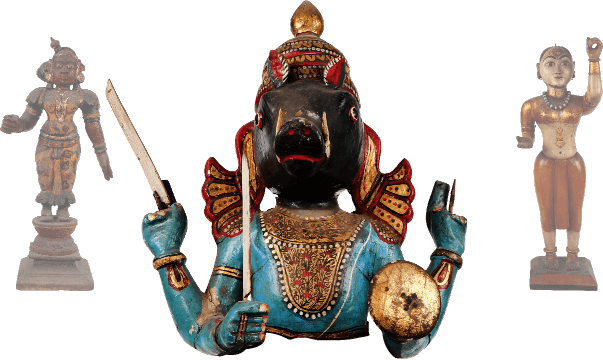Title : Das Mahavidya (Female Deities)
Accession No : 83.7.6585
Tantric painting of female dieties in different forms. The colour scheme is warm. The foreground consists of larger figures while the background consists of smaller drawings of the deities. The figures are depicted in various mudras. There are few religious symbols depicted too.
Gallery
Provenance
- StateBihar
Condition
- ConditionGood
- Action NoteCNR
Contributor
- Artisan / CraftsmanBatoi-Jha
Dimensions
- Measurement (CMS)290 X 146
- Weight (GRMS)0.00
Significance
- Socio economicTo the north of the Ganga lies the Madhubani metacluster that comprises the Madhubani, Darbhanga and Muzaffarpur districts. It falls under the cultural region of ancient Mithila. It is as if the Ganga along with her tributaries, the Kosi and the Gandak, had conspired to endow Mithila with the geographical seclusion that ensured a unique cultural milieu. Home to the conservative Maithil Brahmins,among other castes, this region has highly nuanced caste dynamics that inform all aspects of its socio-cultural life, including the rich craft heritage. The vicissitudes of history saw the rise to power of the Maithil Brahmins around 14th Century AD. Though they were land-holding Zamindars, they assumed the trappings of dynastic rule. The Khandavala dynasty was one of them, and their estate, Darbhanga Raj, was the richest during British times. Independence and democracy ensured the end of the princely states and the Zamindari system, but traces of feudalism still abound. In the strict caste lines drawn around communities, in the accompanying division of roles, in the highly conservative gender roles, in the antiquated social customs, in the very lilt of the Maithili language lurks the Mithila of yore. Mithila’s crafts reflect these influences—thus, Madhubani paintings are done only by women, and the paintings and wall murals of the Dushadhs, who are on the periphery of the caste scale, have themes and motifs drawn from their caste and class realities.
- ArtisticMadhubani painting is one of the many famous Indian art forms. As it is practiced in the Mithila region of Bihar and Nepal, it is called Mithila or Madhubani art. Often characterized by complex geometrical patterns, these paintings are known for representing ritual content for particular occasions, including festivals, religious rituals, etc. The colors used in Madhubani paintings are usually derived from plants and other natural sources. These colors are often bright and pigments like lampblack and ochre are used to create black and brown respectively. Instead of contemporary brushes, objects like twigs, matchsticks and even fingers are used to create the paintings.
Description
- DescriptionTantric painting of female dieties in different forms. The colour scheme is warm. The foreground consists of larger figures while the background consists of smaller drawings of the deities. The figures are depicted in various mudras. There are few religious symbols depicted too.
- Inscription/Markings No
- Reference"Aditi Ranjan, M P Ranjan (2005). Crafts of India, Handmade in India, National Institute of Design (NID), Ahmedabad. Ahmedabad: Mapin Pub. ISBN 81-88204-57-9. https://www.culturalindia.net/indian-art/paintings/madhubani.html"
- KeywordMadhubani, Paper, Pigments, Natural, Goddesses, Ritualistic

